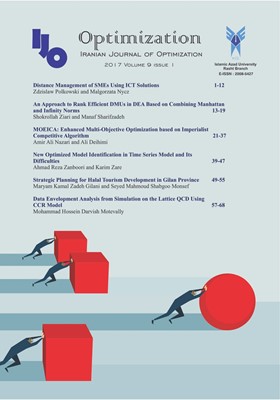Strategic planning for Halal tourism development in Gilan Province
محورهای موضوعی : Strategic ManagementMaryam Kamal Zadeh Gilani 1 , Seyyed Mahmoud Shabgoo Monsef 2
1 - Department of Business Management, Rasht Branch, Islamic Azad University, Rasht, Iran
2 - Department of Business Management, Rasht Branch, Islamic Azad University, Rasht, Iran
کلید واژه: SWOT, Gilan province, AHP model, Halal tourism,
چکیده مقاله :
Tourism as a necessity for economic development in many countries, therefore, in this study we intended to investigate the strengths, weaknesses, opportunities and threats of Halal tourism in Gilan province, by using SWOT model to introduce strategic solutions to further developments. This study is practical based on questionnaire in terms of practical objectives, in terms of data collection. The population of this study was 25 tourism experts, which according to Morgan table, 24 people were selected as sample size.To identify relationships and priority setting criteria , at first internal and external factors were identified and then multi-criteria decision-making models and AHP model was used. After that by using internal factors evaluation matrix (IFE) and external (EFE) final weight determined and at the end the model was design and the strengths, weaknesses, opportunities, threats were analyzed .The result of SWOT analysis in this research indicates that strategies for Gilan provinces according its environmental strengths and opportunities should be offensive strategy. Surveys show that due to the diversity of tourist attractions and geographical location of Gilan province, this province has the necessary capabilities to develop Halal tourism
Tourism as a necessity for economic development in many countries, therefore, in this study we intended to investigate the strengths, weaknesses, opportunities and threats of Halal tourism in Gilan province, by using SWOT model to introduce strategic solutions to further developments. This study is practical based on questionnaire in terms of practical objectives, in terms of data collection. The population of this study was 25 tourism experts, which according to Morgan table, 24 people were selected as sample size.To identify relationships and priority setting criteria , at first internal and external factors were identified and then multi-criteria decision-making models and AHP model was used. After that by using internal factors evaluation matrix (IFE) and external (EFE) final weight determined and at the end the model was design and the strengths, weaknesses, opportunities, threats were analyzed .The result of SWOT analysis in this research indicates that strategies for Gilan provinces according its environmental strengths and opportunities should be offensive strategy. Surveys show that due to the diversity of tourist attractions and geographical location of Gilan province, this province has the necessary capabilities to develop Halal tourism
Ali Pour ShirSavar, H. & MohammadipourKhajani, A. (2012). Effect Tourist Attractions of Gilan on the dynamics. Journal of Tourism Management, 35, 36-32.
Ebrahimzadeh, E., KazemiZad, Sh. & EskandariSani, M. (2011). Strategic planning tourism development, with an emphasis on religious tourism (Text in Qom). Research in Human Geography, 76, 141-115.
Erabi, S. M. (2006). strategic human resource management (guidance), Tehran: Cultural Research Bureau.
Ganjali, S., Shayesteh. K., Ghasemi, A., & Mohammadi, H. (2014). Environmental and strategic assessment of ecotourism potential in Anzali Wetland using SWOT analysis. Caspian J. Env. Sci. 12 (1) ,155-164.
HezarJaribi, J., & Najafi, M. M. (2010). Social trust and the development of tourism, urban and regional studies. 2(7), 70-53.
Kazemi, M. (2008). Analyze the perception of citizens of Zahedan, Chabahar in tourism development. Journal of Geography and Development, 12(2), 100-81.
KazemiZad, Sh., Sabzi, B., Mirbahaei, M., & Karimi, A. (2010). Tourism's role in the convergence of member states of the OIC, Proceedings of the Fourth International Congress on Islamic geographers, Zahedan.
Nohegar, A., & HosseinZadeh, M. M. (2009). Evaluation capabilities enjoying Jqshm island tourism management model Strategic SWOT.Geography and Development, 15, 172-151.
Seydayi, S.E., & HedayatiMoghadam, Z. (2010). Security role in the development of tourism. Quarterly Journal of Social Sciences, Islamic Azad University Branch,4 (8), 110-97.
Sobhani, B. (2010). Recognizing the tourism potential of the basement spa area in Ardebil Province using SWOT. urban and regional studies, 1(4), 128-113.
ZangiAbadi, A., Mohammadi, J., & ZirakBash, D. (2006). Analyzing domestic tourism of Isfahan City. Journal of Geography and Development, 8, 156-131.


